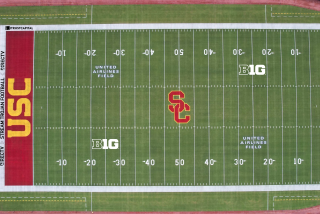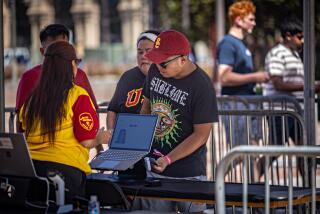Universities Turn to Summer Rentals as Moneymakers
- Share via
Once June rolls around, many college campuses enter a lull, with the senior class and vacation-seeking undergraduates gone.
But local university officials say the students’ flight only marks the calm before the storm.
Each summer, UC San Diego, San Diego State University, University of San Diego and hundreds of other universities nationwide throw open their doors and rent parts of their campuses to a host of summer clients from cheerleaders and senior citizens to working professionals and professional sports teams.
By renting out dorm rooms, campus facilities and catering services to a variety of organizations, colleges and universities generate millions of dollars during their academic “off-seasons” to help pay for campus repairs and improvements.
And, at a time when spiraling tuition costs are threatening to deprive many teen-agers of a college education, university administrators say summer revenue also helps to keep prices down.
“The money often goes to reflooring the gym or for housing improvements, expenses that otherwise would be passed on to the student,” said Michele Nichols, president of the Guide to Convening on Campus. The Denver, Colorado-based publication lists 325 U.S. and Canadian colleges and universities that rent out their facilities.
“Much of the revenue generated during the summer goes toward building up our scholarship fund,” said Maria Martinez-Cosio, a USD spokeswoman. The summer conference program at USD, which provides facilities, meeting rooms, housing and meals to 6,000 adult and youth guests, generates about $1 million each summer.
How much a university makes during a summer depends on several factors, including a school’s marketing efforts and its facilities available for rent. Small campuses with 2,000 to 5,000 students generally raise $50,000 to $200,000, Nichols said. Bigger universities with 15,000 students or more often generate $1 million to $3 million each summer.
“It’s become an excellent source of revenue,” Nichols said. “But, more important, summer programs give campuses tremendous exposure. It allows them to show off their campus to lots of teen-age kids who might be there for cheerleading camp or who might have shown up with a religious youth group. It’s a great recruiting tool.”
For more than 20 years, colleges and universities have housed guests in dorms or rented its facilities to small groups in need of meeting places. But, during the last decade, as an increasing number of schools have recognized the profit in summer rentals, university officials have intensified marketing campaigns to attract summer clients.
“It’s become quite competitive . . . . Now, you have to go out to these (meeting planners’) trade shows to attract business,” said W. G. (Woody) Woodrow, SDSU’s associate director of housing and residential life. Woodrow said SDSU sends direct-marketing pieces to clients and advertises the university’s facilities in industry publications.
Woodrow said such efforts have paid off: In the early 1980s, SDSU raised $200,000 to $300,000 per summer. “That’s increased steadily, and now we’re looking at our third $1-million dollar revenue summer,” he said.
College campuses have much to offer, everything from athletic fields to extensive library collections, administrators say.
“Clients are scrutinizing their budget and taking a hard look at what they’re getting accomplished at their meetings (at hotels),” Nichols said. “Some are looking for a change of pace, a place with fewer distractions.
“For example, if you have to train new employees, say they’re in a six-week program, what better place to take them than to a university campus,” Nichols said. “You have access to libraries, audiovisual equipment. You’re in a learning environment with tree-lined streets and ivy (clad) buildings.
“Many clients haven’t been back on a college campus since they graduated,” Nichols said. “A lot of them say it’s very nostalgic, very refreshing.”
Perhaps most important, college officials say, they offer what budget-conscious meeting planners and camp organizers want most: cheap housing.
University dorm rooms can be rented for as low as $10 to $18 per night per person and rarely exceed $40 to $60, Nichols said. Food service, consisting of three meals daily, typically costs an additional $15 to $50 per day, Nichols said.
But staying on campus isn’t for everybody, warns Richard Scharf of The Guide.
“Some people aren’t thrilled about using a communal bathroom,” Scharf said.
But Lene Hartman, UC San Diego’s conference manager, said the La Jolla-based campus has been able to satisfy many groups’ needs.
The university has been renting its facilities since the campus opened in 1967, but, back then, UC San Diego hosted fewer than 200 people per summer. Last year, 12,000 people from 70 different organizations came and used UC San Diego facilities during the 10-week summer session. The university generated $1.5 million last summer.
This summer, the Chargers will practice on UC San Diego’s fields, and more than 1,400 participants are expected to attend an international symposium on bioengineering, Hartman said. And the United Spirit Assn. is scheduled once again to hold its cheerleading camps on the school’s campus. The camp runs four sessions at UC San Diego with more than 500 teen-agers attending each session.
“Our camps primarily involve high school and college students who are only available in the summer, the same time the dorms are available and when university officials are anxious to fill them,” said Michael Olmstead, USA president. “Using a college campus is kind of a natural fit for us.”
More to Read
Sign up for Essential California
The most important California stories and recommendations in your inbox every morning.
You may occasionally receive promotional content from the Los Angeles Times.













